What makes quality jeans – and should you care?
A reader commented recently (I paraphrase): “Why should I care about old jeans? They were all mass produced and basically the same.”
There are a couple of things wrong with that. The first is that mass production doesn’t necessarily mean lower quality. It often does, but anyone that’s seen Loro Piana weaving, or Hermes silk, will know scale can also produce the absolute best quality.
The second, more important point builds on the first. Jeans have not always been the same. Mass production of denim used to be much better, both because of better materials and better processes.
That’s a reason for buying, for example, vintage from the 1960s rather than 1970s. But that same quality of production can also be seen today, if you know what to look for.
Today’s article is intended to provide a breakdown of what factors make quality denim; the effect each factor has on your jeans; and finally, which ones I would personally prioritise.
When you read that a pair of jeans uses synthetic indigo and is ring spun, you’ll know what that means - and have an opinion on whether you should care.
Cotton
The cotton that goes into denim is arguably the most important factor of all. Rather like cooking, if you start with good ingredients the end result will be good, no matter how simply it’s made.
I can’t take credit for that metaphor. That goes to Illya of Blackhorse Lane Ateliers, who along with designer Leanne, helped me with the technical details on this piece as well as giving me their opinion on what they would prioritise.
“With cotton the important thing is to have a long staple, which normally comes standard when you source from a particular area, such as Zimbabwe cotton,” says Illya. And what effect does that have? “It means the denim is stronger, but also softens better over time as well - that’s why those old 60s Levi’s are so soft after so long.”
I can see that with my various old Levi’s. An old 1990s pair I have has been worn to death - and looks great in that way - but the cotton has become stiffer and coarser over time. The denim on my 1960s pair, by contrast, is incredibly soft.
Being long staple also creates greater character: you get more noticeable variation in the denim. “Cheap cotton is made up of shorter fibres, and looks more uniform as a result,” says Illya. This is something that will come up repeatedly in this article: premium denim has more natural character to it (eg above), where others are smoother and more uniform.
Which you prefer is a personal choice - they're just different looks. I prefer the variety of fading and colours you get with more characterful denim, but that's my preference. I'll explain why, then you can make up your own mind.
Other aspects of the cotton don’t matter as much as the staple length. Fine cotton isn’t a priority, unlike with luxury suitings or shirtings, and while organic denim is nice, high-end cottons are usually produced in a more sustainable way anyway. You need to use fewer pesticides and take better care of the soil to produce that type of plant.
Spinning
There are broadly two options here, ring spun and open-end spun.
Ring spinning is the original method, invented in the US in 1828, and involves thinning the cotton using frames before twisting it. Open-end spinning has been used by most manufacturers since the 1970s, and is like the methods used for making materials for shirts or tailoring.
Ring spinning costs more and takes longer, but produces a softer, stronger yarn, and one with slightly more variation - similar to the distinction between long and short-staple cotton. Open-end spun denim also tends to have a cleaner finish.
“Italian mills like Candiani prefer open-spun denim, because they want uniformity and consistency,” says Illya. “The Japanese, on the other hand, have largely stayed faithful to the old methods and produce more irregular, perhaps more interesting denim.
“We use Candiani as well as something Japanese like Kaihara, because we want to offer customers both. You can spot Italian denim from a mile off - it’s so much smoother and more refined.”
Both Leanne and Illya said they preferred ring spun, but suggested someone who was into tailoring might prefer something smoother. I found this interesting, because despite being a tailoring nerd, it’s the natural, organic look I love. To my mind the difference is more similar to fine shoes, where menswear enthusiasts value the patina the leather acquires over time, rather than a uniform surface.
Dyeing
There are broadly two options here as well: rope dyeing (above) and slasher dyeing. (This is dyeing the yarn, we’re not getting into dyeing the cloth or the finished jeans - piece dyeing or garment dyeing.)
Rope dyeing is the original, slasher dyeing an invention of the 1970s. Interestingly, many of the inventions were made in Europe, because Europeans had seen worn-in blue jeans from America and wanted that, rather than the dark, raw denim they had started as. Hence Italy’s dominance in this area.
The difference between dyeing and spinning is that a lot of denim today is still rope dyed. That’s because rope dyeing leaves more of the denim white, creating that fading that everyone expects from jeans - or wants immediately from washed jeans. With slasher dyeing - in sheets rather than ropes - the yarn is exposed to the indigo for longer and absorbs more.
When it comes to the indigo used in the dyeing, nearly everything is synthetic. This might seem surprising, given the emphasis on natural processes everywhere else, but synthetic indigo has been used since 1897, and took over natural indigo as the most popular choice in 1913.
As a result, all the denim we’ve seen uses synthetic indigo, and that’s what we expect. Natural indigo has a rather green cast, fades more slowly, and doesn’t produce high-contrast fades.
Weaving
Another dichotomy here: shuttle looms or projectile looms.
Generally, denim woven on a shuttle loom (above) will be woven slower and as a result have less tension and more slubbiness. Both characteristics generally favoured by enthusiasts - and which line up with long-staple cotton, ring spinning and rope dyeing.
However, there is more variation among mills here, with some good denims being produced on projectile looms - just with better ingredients and other processes.
Also, the split between types of loom is a simplification, as you can get faster and slower projectile looms, and even ones that intentionally reproduce the ‘loom chatter’ that Cone Mills looms used to get from sitting on wooden boards rather than concrete floors.
The issue is further complicated by the issue of selvedge.
The selvedge (self-edge) is the strip that runs down both sides of a piece of denim, stopping it from fraying. It’s usually used on the outside seam of a pair of jeans, and so is visible if you turn up the hem (above).
Selvedge used to be a guarantee of quality because it indicated how the denim had been made. But some brands have been known to put fake selvedge on denim, or simply to weave it with a selvedge but use cheap raw materials, because the selvedge is what people care about.
“The thing is, selvedge only indicates one aspect of how denim has been made, and you need all of them to produce great jeans,” says Leanne.
Still, at an absolute minimum, selvedge does indicate that the manufacturer has gone to some kind of effort to give the impression of quality. “And if you add that to the fact it’s Japanese, you pretty much know it’s going to be quality without knowing everything else about the processes,” Leanne says.
Some of the factors that go into denim are mixed up: quality cotton, for example, that is slasher dyed and woven on a projectile loom. But usually, there is a clear difference in the intended look: natural, varied, fading or smooth, consistent and homogenous.
I've illustrated the difference above - an Italian denim from P Johnson on the left, a Japanese jean from Full Count on the right. I can see how some people might think the left is easier to wear, particularly with smarter clothing. But to me it looks like an imitation.
Below, I've shown some close-ups. First of raw denim, comparing open-end spun/slasher dyed to ring spun/rope dyed; then worn examples. The difference is there, but not that marked, on the raw denims. Once they're worn and washed it's pretty obvious.
I’ve already pointed out the parallel with shoes, but perhaps there’s one with flannel as well.
The reason I don’t like worsted flannel is that in order to make the material lighter, most of the things that make flannel attractive are removed - its softness, its fuzziness, its handle. I don’t want to sacrifice all of those in order to get a flannel I can wear in summer, because it isn’t actually flannel any more. It’s something different.
The same is true of denims that are trying to be smoother and less varied. You’re making a denim that is easier to produce and sell, but at the expense of some of things that made jeans attractive in the first place. At the very least, it's a different type of material.
Many thanks to Illya, Leanne and the rest of the Blackhorse Lane team for their help with this article. You can read about how jeans are actually made, and Blackhorse Lane’s unique take on it, in a previous article here.
We also covered raw denim, washing it and sizing it, quite thoroughly in a previous article here.
If you want more detailed technical information, Heddels is one of the best resources on the web.
Credit for the close-up images goes to Illya at Blackhorse Lane.


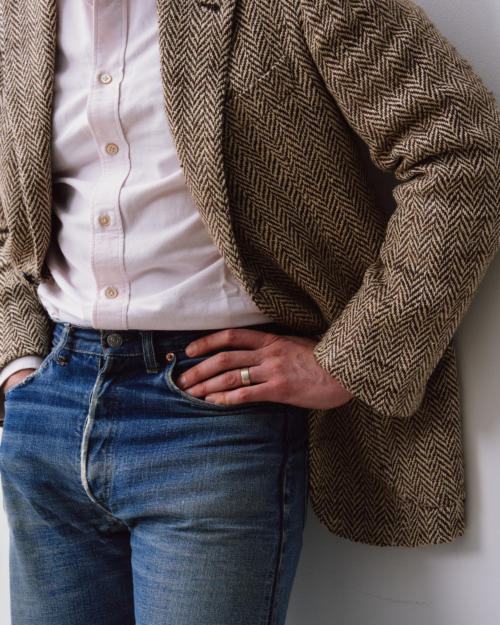
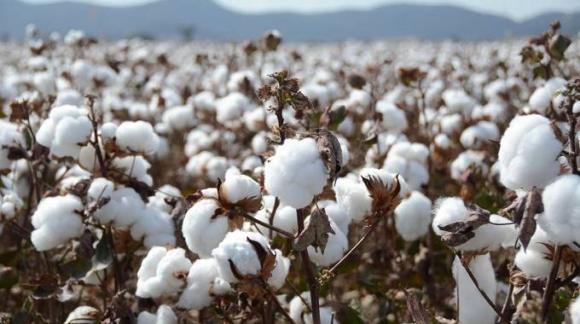
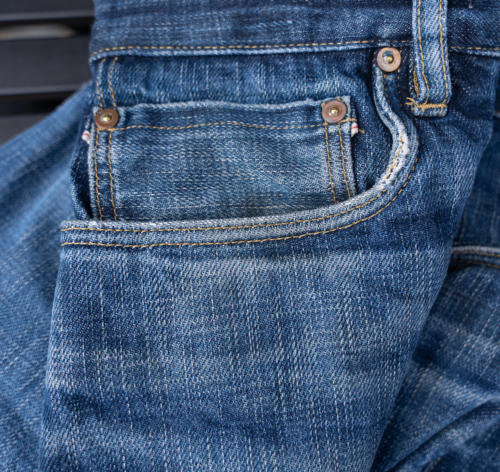
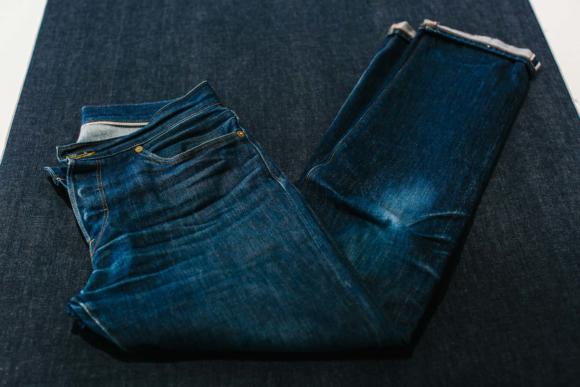
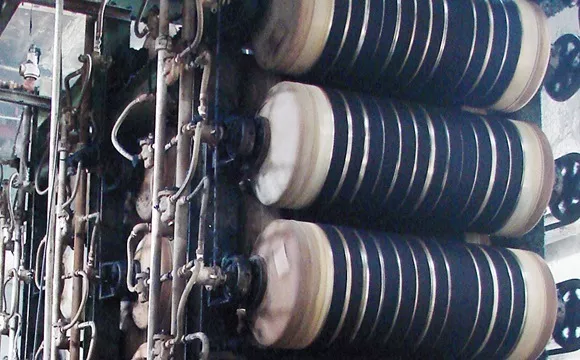
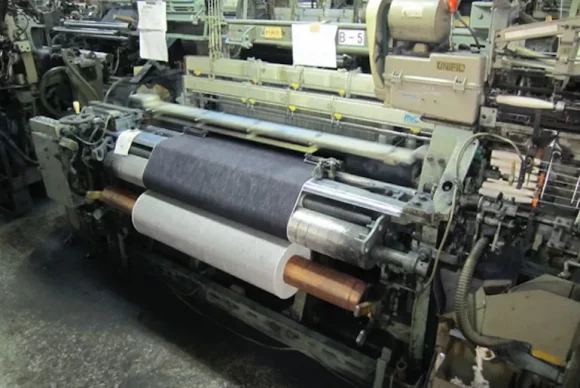
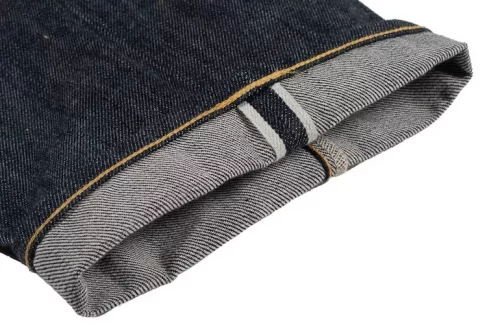
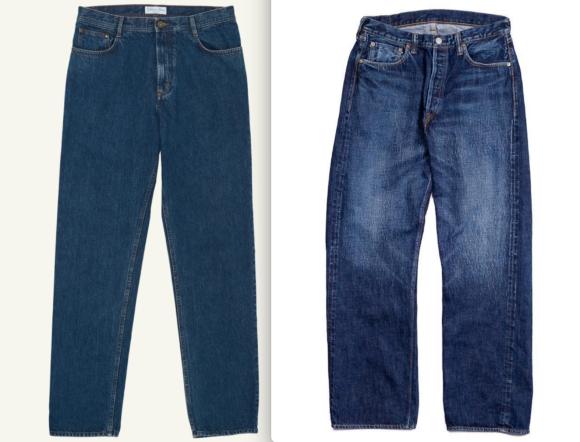
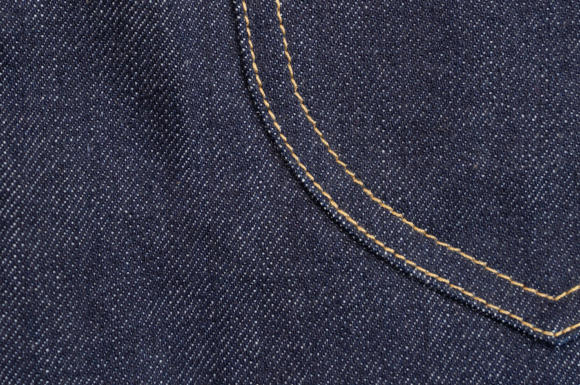
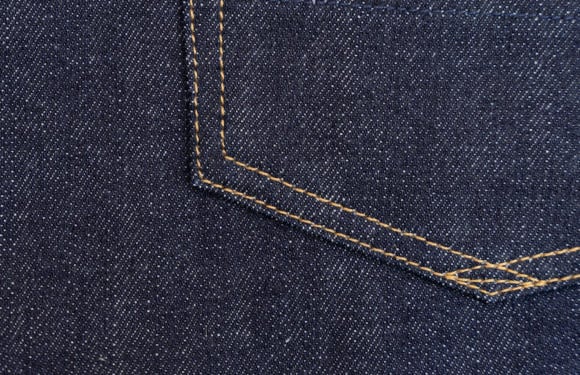
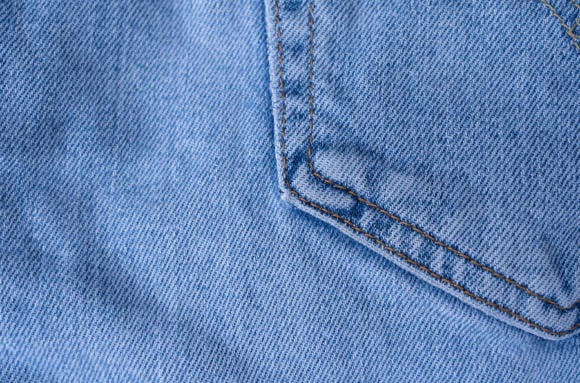
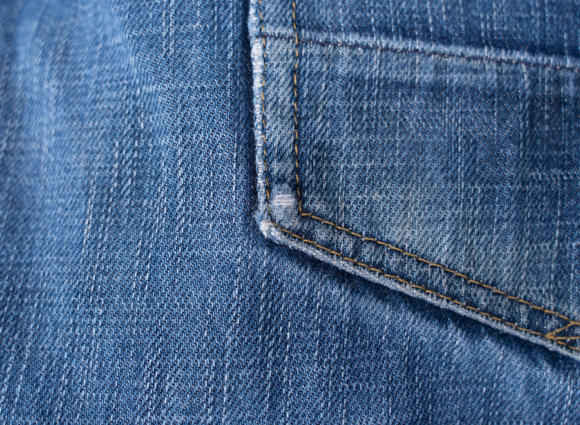
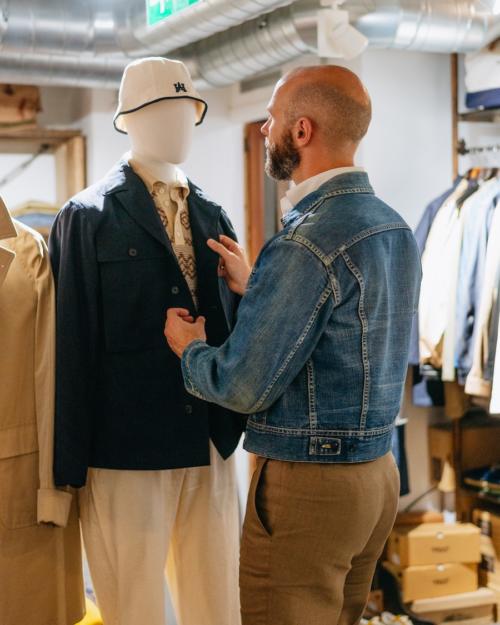

























What about jeans such as these?
I have same jeans as these with no fading and therefore does this also look like an imitation.
My point about imitation was about artificial fading, so no these don’t look like that. However, I assume they aren’t made in any of the ways described for higher end denim, so they won’t get the same character as they fade naturally
Have you come across linen denim before?
https://www.stuartslondon.com/naked-and-famous-denim-weird-guy-raw-linen-denim-natural-p54846
I’m tempted by the 9oz weight for Summer
No sorry, haven’t tried it.
Aaahh.
I remember persuading my mum to buy me some Levi’s wen I was about 14 in 1970. There was one place in Bradford market where you bought them – shrink to fit, so you bought oversized. They were about £5, when you could buy terrible uk made ones for less than a quid.
They were like furry black cardboard, with all those lovely card labels, and had this strange waxy smell. When I got home I laid in the bath in them, to shrink and mould, turnin* the water dark blue.
i lived in them for 2 years till I grew out of them, and they became the most beautiful jeans I hav3 ever had.
in the scruffy old market stall where I bought them there was a Levi’s poster of two beautiful girls walking away from the camera in the Californian sunshine. One had a lovely old faded pair of jeans, adorned with patches and embroidery. The other had brand new pair with a little patch saying “Running in, please pass”.
Maybe the expression “uncanny valley” is apt for the comparison between jeans that don’t fade naturally and those that do: one of these things has been made to look like the other, but it’s not behaving in quite the same way.
“And if you add that to the fact it’s Japanese, you pretty much know it’s going to be quality without knowing everything else about the processes,”
To Simon and fellow readers, please: Does that mean, I can get good quality Japanese denim also with cheaper brands like Edwin (their more expensive, made in Japan offering, cloth from Japanese mills like Kaihara etc.)? To my eye their denim looks like I would expect from Japanese denim: rugged, slightly uneven and somehow fluffy/hairy on the surface. I have trouble finding a good fit with expensive brands like fullcount. But I was still wondering if the 100€ that I would pay more would also necessarily result in a better denim material? (I am sure there will be other details that justify the fullcount price, but I wanted to keep the focus on cloth now.) Thanks for your input!
I don’t know the details of the Edwin denim Alexander, and perhaps I can ask Illya or someone else to reply if helpful, but I suspect the answer is yes, you can get good quality denim from someone like Edwin, fulfilling most of the points in this piece.
With Full Count there will just be smaller things they do as well – when what you’re aiming for is (to them) the ultimate denim, no expense spared. That might mean using Zimbabwe cotton rather than another long staple, for example, or a particular thread or patch.
Thank you! I was also reminded of something you said before about tailoring-mills: that it is not helpful to only know the mill, because they often have different quality levels.
My problem in other words: my edwin denim is a 14oz cloth from Kurabo Mills. Blackhorse Lane are also offering a 14oz cloth from Kurabo Mills. What am I missing because I spent over 100€ less? Maybe also those denims mills vary a lot in their output.
They don’t really to the same extent Alexander. You would need a different set of very expensive machinery to start, for example, doing a different type of dying. It may be the cotton is slightly different, as I mentioned, but the basics will be the same.
Also, the price difference might be to do with other things, like the fact BLA are made in London for example (and made in a different, much cleaner way that requires more time – see post I link to on that)
Thank you! And yes, those other reasons for the price difference are obvious.
If I may offer my opinion from Japan. The difference in cost might merely be economies of scale. Edwin are a huge denim/jeans brand over here and perhaps only rivalled by Uniqlo in terms of market presence and overall popularity. I have never been a particular fan of Edwin but that is more to do with length and cut of the legs. Being long of limb does have it drawbacks sometimes.
I used to wear Edwin – I’m not sure about objective measures of quality but they wore in and softened really well. And the cut really suited me. But overall I prefer ironheart and BHL – I think over time wear a bit better. And they have a nice variety of cuts.
Once I started into tailoring, and realised it would be a quite expensive process (and no longer worked in an office), I went down the rabbit hole of Japanese denim and started spending my money on workwear. Simon has probably said this, but good quality jeans last. I’m still wearing a pair of Sugarcane’s 2014 jeans (12 oz) I bought in 2019; slow to break in, but once they do, soft, as Simon mentioned. As I already own from Iron Heart an N1 Deck Jacket and a melton wool CPO shirt, and found the construction to be excellent, I bought a pair of their 21 oz relaxed fit 888 model – partly for the “challenge”, but also because the photos of them broken in look great. It’s said everywhere, but despite the weight, they’re very comfortable. If you don’t overbuy and perhaps have two pairs of good jeans, they’ll last a long time. I also have a pair of Rag and Bone’s classic fit jeans from the USA. I’d rank the Japanese denime above them. Final point, Tellason from the USA have a good reputation. I own their Coverall denim jacket which is 16.5 oz, and it’s a nice riff on a chore jacket theme.
Interesting how different we think of stuff “lasting”. I bought a basic pair of Levi’s for under 100€ in January 2018, and they are just now coming close to needing repair.
That sets quite a high bar for jeans for let’s say 500€, needing to last over two decades for the same “cost per wear”. I’d love to hear if anyone has experiences like that.
I know there are many more benefits from buying higher quality than longevity, but I can’t help but feel to my big disappointment that the whole “cheaper in the long run” or “investment” thing is a myth.
As I said, I’d love to be saved from my disillusion.
Some things can be cheaper in the long run if you buy quality Leonard, but denim probably isn’t one of them. A better suit is easier to alter, the canvas won’t be fused and bubble when wet, etc. Shoes too if you look at the lower-end English type perhaps.
But a pair of Carhartt work chinos will be less than £100 and outlast pretty much anything. It’s a coarser, tougher yarn, which is cheaper.
You have to take things differently for different categories. And you’re paying usually more directly for how something looks as it ages, not that it just lasts longer. A plastic tote bag will last forever (in landfill as well) but it will look terrible, whereas a good leather bag will start looking good and only look better and better.
Also, don’t compare to the very top end of the jeans market, at 500 euros. By that point you’re paying for very niche production techniques and details. Much better to compare to a solid pair at 200 or so – which is very achievable with the kind of denim we talk about here.
Yeah, I guess at a certain point you do run in to the law of diminishing returns.
Either way, it is always going to be better to repair than buying new. Shoes as you say are probably the area where the possibility to repair makes it economical in the long run to go for a better pair.
And I agree with that you get other things, such as ageing more beautifully, with more expensive stuff.
If Simon doesn’t mind me mentioning… Heddels is a great way to go further down the denim rabbit hole and will help with answering your questions further
Not at all CJ – I say that at the end myself!
Interesting information, thanks! I would still say the number one, two, and three priority for jeans is whether they have a flattering and fashionable fit. Also, I find that pronounced and uneven fading always looks messy – I would actually much prefer the evenly faded look from the open-end spun/slasher dyed denim above. In general, I have never understood why some people would obsess so much about the “correct” look of denim – not everyone is into workwear cosplay.
Thanks Felix. I think the important thing is that you understand why some people prefer that different look, as I’ve tried to do a little here, and then make your own decision.
But it’s definitely not about workwear cosplay. It’s about getting a good pair of authentic jeans – as everyone wore for decades, with an Ivy look, with anything, until fashion jeans took over.
Fair enough – though tbh by now it’s also been four to five decades that people have been wearing what you call fashion jeans – claiming that those aren’t proper jeans seems a little like explaining that trainers should actually only be worn for physical exercise.
Apart from objective stylistic considerations like how much color variation one likes for their trousers (I personally dislike overly busy color schemes), these days denim geekdom seems to be deeply embedded in a subculture I personally associate with men experiencing a midlife crisis, outdated motorcycles, leather jackets, repro militaria, flat caps, historic workboots, beards and hair loss, obscure whisky brands and “artisanal” coffee, etc. etc. – all in all, the opposite of cool and a niche I try to stay clear of. But maybe you and others have different associations.
But nonetheless, interesting content from a technical point of view!
PS: Denim and the Ivy look?
Yeah, I think a lot of that is those associations. People have been wearing cheap suits for decades too but that doesn’t mean a bespoke made one is any less beautiful.
Denim and Ivy, yes great idea for an article. Anathema to Ivy at the start, but then a big part of how it evolved
Beware all that enter the serious denim world…..
it can all too easily lead to denim geekdom. I know what you are thinking; you will buy one pair of entry level selvedge, you can handle that but its not that simple, it will lead to harder class A denim and soon you will be addicted and then denim takes control of another life. I am that man…. I cannot even say out loud how many pair I own, I research constantly, keep aware of new products, seek reviews and then buy as and when, even planning some trips around ”oh I can call into that denim shop” I am on a quest for the holy grail of denim, that pair of jeans that looks perfect, fits perfect, fades to perfection and lives to tell the tale. Of course they dont exist, we dont want them to exist because we love the hunt, we are by nature hunters. Oddly I know each pair I own and wear them or not I love them all for different reasons. Addiction is one thing, but FFS please dont become a denim bore, nobody deserves to be next to me at a dinner table when some idiot makes the mistake of asking my opinion about a pair of jeans.
PS – the journey is always worth it, worry not about arriving at the destination. If I was ever to find my perfect pair and thence stopped looking I would need to take up golf (please lord no) or some such to fill my spare time. ”What makes quality jeans and should you care”? Well for the former its fun to discover what, and for the latter, ‘yes’.
Cheers Gary – if I’m ever next to you at that dinner table, don’t worry about boring me…
For everyone else though, it is possible to get good denim without disappearing down that rabbit hole!
Yes, fair point, well presented; I should have added that you can get tip top selvedge togs without becoming an addict…. and without spending a huge fortune.
I too would be happy to sit next to you at the dinner table. Then you can ask me about my search for the perfect blue jacket! My wife thinks I will never succeed, but as you say it’s the hunt that’s important.
By the way, I mentioned in another comment a program called Riveted (originally on PBS America ) about the history of jeans, which you may be able to find on a streaming service although you may well have seen it. All the best.
Thanks Stephan, I’ll have a look
One thing which struck me is the differences between quality (but identical jeans) . I tried two pairs of the same Iron Heart and there were definitely differences in both fit and feel – one was more ‘slubby’. I imagine they were different batches, made by different people.
Thanks Stephen, let the hunt continue for all ‘perfect’ things
Sounds like denim takes over the space many men reserve for automatic luxury watches.
I do (or did) the luxury watch thing as well but not in such large numbers…..
My watch collection comprises 3 x Rolex, 2 x Bremont, 1 x Panerai, 2 x IWC and 1 x PP.
All my jeans are 501’s, which fit perfectly. Oldest pair c 1970, newest c 2005.
Chacun a son gout.
Hi Simon,
Another great informative article. I really do enjoy these. As I have previously commented, how things are made are always of interest to me.
On a related point readers may be interested in a complimentary television program called Riveted, that was originally on PBS America shown on Sky UK. Unfortunately not still available on Sky, however it may be available on other streaming services now or in the future. Worth a watch if you are interested in jeans. .
As to the second part of the question what’s important or not, is a personal range of opinion. Interesting to see the comments on this – I think we are all nerdish to a greater or lesser extent – it’s what’s make these diversions such a joy.
Thanks again.
Hello Simon. These are my two pairs of denim jeans I own. The first pair is from The Armoury by Nigel Cabourn Indigo Jeans on the left (Unworn) https://thearmoury.com/collections/denim/products/the-armoury-by-nigel-cabourn-5-pocket-denim-jeans?variant=17728986415175. I bought a waist size 30, it needed alterations, I got the alterations done from BLA to waist size 29. The second pair is from The Real McCoy’s Lot.001XX / Washed Blue Jeans on the right (Unworn) https://therealmccoys.com/collections/bottoms/products/001xx-washed. I bought a waist size 29. The latter I solely bought on your recommendation. I’m extremely pleased with their quality. They’re both made in Japan.
https://youtube.com/shorts/bHdd_hcSZew?feature=share
Hello Simon. I was looking at these https://www.thearmoury.com/collections/denim/5-pocket-denim-jeans?variant=39524920328263. I now do own pairs of The Armoury by Nigel Cabourn Jeans in Indigo and The Real McCoy’s Lot.001XX / Washed Blue 14.5oz. I’m looking at these jeans from The Armoury’s as an summer option as it is 12.5oz as opposed to my The Real McCoy’s 14.5oz that I intend to wear in F/W or when temperatures in India are below 30 degrees celsius. I find the 12.5oz weight works in a Tropical country like India and 12.5oz pair of jeans can pretty much work all year in India climate. I must also add here that it’s almost impossible to find an Japanese denim at 12.5oz as most due to their making process are heavier denims. The Armoury’s is the only place (or at least of I know of as I’ve almost looked everywhere elsewhere) that has jeans at 12.5oz. Let me know your thoughts on this one?
I can see how a lighter-weight pair of jeans might work better for where you live, although it’s not a big difference in weight.
If you do get them, though, I’d say you should find a good home for the heavier pair. Nice to wear in just one
Hello Simon. Your suggestions and thoughts are invaluable to me and hence I look forward to it. I already have 3 pairs of Jeans, my OrSlow’s Takumi drawstrings trousers (yet to arrive from the US) and my OrSlow’s Fatigue trousers that makes a capsule of 5 trousers to rotate and wear them. I also have 2 pairs of OrSlow’s New Yorker ripstop trousers in pale yellow colour to lounge and wear at home and around (all seasons). That very much completes my capsule of trousers to rotate and wear. That will suffice. Thank you Simon ?
Also I think this is an Mid-Blue in colour?
Yes it looks like it
This is really interesting, and the detail matters. I’ve had some (newer) Levi’s and the way they faded was terrible (looking messy and worn out). Given they are Levi’s I got disillusioned and thought it was just what denim did, and that the level of wear meant that they weren’t for me. Since then, I’ve bought some Lee Rider Dry 101’s. Incredible. I would go as far to say they are the best jeans I have ever seen, let alone tried on.
The only new Levis worth buying nowadays are generally reproductions of particular models that are now considered iconic. They’re expensive but are light years from their standard offerings.
https://www.levi.com/US/en_US/levis-vintage-clothing/levis-vintage-clothing-for-men/1947-japan-501-mens-jeans/p/475010219
This is an informative post, though I wish it went into greater detail about how the consumer can actually determine the variables mentioned. The Italian vs. Japanese distinction photoed can be quickly determined by feel and appearance, but I buy exclusively raw selvedge denim and there’s a huge price range within that category. I have nothing but brand reputation alone guiding my selection. Cotton quality, in particular, seems unknowable.
Thanks Ben. It is hard to tell unless the manufacturer goes through all the details mentioned about the material and the processes. However, you can make a good estimate from where it is made, being selvedge, the brand as a whole, and the price.
As mentioned to a reader above, there is still a big price difference among high-end denim, but the point of this piece is to demonstrate the difference between all of those and much cheaper jeans – the reader’s initial comment about a £70 pair of Levi’s
The book Ametora, which chronicles various elements of Japan adopting Americana clothing, goes into some detail about jeans being reverse engineered by Japanese makers. I particularly remember one passage about companies taking apart jeans stitch by stitch, to the point that they dissected the cotton fibre and realised they needed to get long staple cotton to recreate old Levi’s.
Simon can you suggest 3-4 brands with increasing price ? Like for example the capsule prices. But if you find the idea good for an article i can wait 🙂
Nice idea, yes perhaps that would make a nice piece – so you mean ascending prices, and what you get at each price?
Yes exactly and maybe some infos about each brand, and fit comparisons.
I’d second that
Great article, Simon. I’m commenting for the first time to ask: Have you tried Orslow denim? Whenever I read your articles about denim/workwear, I think to myself: This guy would love Orlsow.
I have a few pairs of Orslow jeans, and I prefer them to other brands like Iron Heart or Stevenson Overall Co. The 107 cut is gloriously simple, the fit fantastic, the denim rough yet soft. They also make great cords and fatigue pants.
I haven’t Seth, no, though I know others that have them and love them
for all the 30 plus pair of jeans I own; Orslow are my current ‘go to’ jeans. I use both 107 and 105, both in one wash and 2 yr wash, depending on the mood. I don’t, however wear them with tailoring so that’s something to consider. With tailoring I would select Blackhorse Lane or an older pair of Armoury jeans, maybe a few of the RRL in my pile also work well. Orslow jeans – just say yes.
and yes I also wear their fatigue pants…. perfect as they are not as wide/baggy as original vintage issue pairs.
I’ve heard the inseam on the 107’s is deliberately short (30″?) which wouldn’t fit me otherwise they do seem close to perfect jeans.
By a funny coincidence it was only this week I was telling my wife that I needed a new pair of jeans. My go to brand over the last decade has been Uniqlo as I like the fit of their jeans. I also like the fact that they are Selvedge and as I wear my jeans with a turn up this is important. My wife however pointed out that my jeans always blew out at the knees and crotch after a year and wouldn’t I be better off buying a more expensive pair that would last longer. I am unsure. I wear jeans everyday and often two pairs in rotation.I am unsure if even the best quality denim would stand up to a year of almost constant use without being reduced to tatters. I have tried an Indonesian company called Sage and they do a very heavy denim jean which feel indestructible but they are very heavy and unsuitable for Summer wear.
I guess a few things Dan:
– Yes, you should try better denim. For longevity but also for how they feel, so you know
– Generally materials will wear through faster if they are not allowed to dry out. It might be worth always rotating jeans so they’re not constantly worn every day
– Do you have your jeans repaired when they blow out? This is half the joy of good denim for me – there’s precious little other clothing where you can do that
Is there a link between weight of denim and longevity,Simon? Or is that too simplistic?
There is, absolutely, but as is often the case it’s not quite that straightforward either – there are other little variations
I was chatting to a chap at a denim place that offers repairs for all their jeans. He noted that the heavier weight jeans tended to go at the crotch more quickly than the mid-weight ones. Something about the stiffness of the fabric.
I have had them repaired but it can be expensive for multiple patching. For Uniqlo jeans at £35 there seems no point. Another thing is that although Uniqlo uses Kaihara denim it contains some other material for the stretch and it doesn’t seem to age aswell. Since reading this article I remembered I have an old pair of Nudie jeans. It appears Nudie will repair these for free in their Soho store so I am going to do that.
Nice. I feel like if the jeans are so cheap it’s not worth repairing them, it’s not a good sign. Not great sustainability wise either
Dan, if you wear jeans as often as you say and you completely wear them out, then you’re totally justified to buy a more expensive pair. You will enjoy them far more, and once you take the plunge, you will never go back to cheaper denim. If you’re unsure, then Levis LVC range are good starting point, although not Japanese, still pretty good quality and you can often find them discounted here and there. But those Japanese jeans at SonofaStag and Clutch Cafe are a completely different animal, and you will know the moment you touch them (you may not prefer that animal for the reasons Simon highlights, but still)
I wear Uniqlo jeans to and also have noticed they wear out fairly quickly. I like the fit.
Maybe you could try having four or even five pairs in rotation? As an alternative Nudie brand jeans might work.
Hi, Simon. I’m a regular reader despite not being a tailoring nerd. For me this is one of the most interesting posts because I wear a lot of denim on different occasions paired with different types of clothing. I have to admit best denim I own are from Club Monaco (Japanese denim) I don’t know anything else about them and 7 For All Mankind. (made in Turkey that’s all I know). I must say I find 7 For All Mankind very comfortable. I’m interested in your opinion about those brands?
Thanks, that’s great to hear.
I don’t know enough about either brand to really comment on them though – sorry
I think there’s a convincing case that high quality jeans (e.g. BLA) are the best value ‘luxury’ purchase around. Jeans are a wardrobe essential and will always get a ton of wear. Good jeans are easier to find in decent fits, simple to look after, and continue to look great after years of use, abuse and repair. A pair of high quality jeans may be 2.5x or 3x the price of a pair of new 501s. That’s not cheap, but factor in the quality of make, far better materials and (in the case of several makers) free repairs and they work out exceptional value.
Do you have an opinion on the use of wool in Denim fabrics? Holland and Sherry do it.
Only that it’s not really denim at that point. It might still look nice, and be what you want, but it’s a very different type of material. It will not hang, wear in, feel or fade like denim does. It’s more like a denim-coloured twill tailoring fabric.
While I’d reemphasise that it’s about personal preference, it does remind me of what a friend said once about big coffees from Starbucks – they’re not coffees, they’re coffee-flavoured sugar milk.
That material from H&S may be made to have some things in common with denim, and look great for it, but it’s not really denim.
“While I’d reemphasise that it’s about personal preference, it does remind me of what a friend said once about big coffees from Starbucks – they’re not coffees, they’re coffee-flavoured sugar milk.”
Amen to that! As I tell my wife and daughter (good naturedly of course) – if you need to add milk and sugar then you don’t actually like the taste of coffee.
Always really liked C-17 jeans in my teens and twenties. Length of leg and how they softened over the years. Glad to see them back (see link).
Simon-is there a reason why French made jeans/denim seems to have fallen out of favour? Seems strange given the etymology of ‘denim’.
I think it’s a very long time since that material from France Dan, so it’s not really that relevant any more. The English may have invented the modern suit, too, but we have no real suit manufacturing capability outside bespoke any more.
It’s just about development of industry – Japan did a huge amount to develop in that way, and Italy has just about held on to its production. But the UK and to an extent France have historically been worth at that.
Some jeans brands offer free repairs and do recycling in some manner. For this reason I only bought one particular brand the latest ten years or so. It does not hurt that they seem to be of decent quality. Wonderful to have ”solved” jeans! (Nudie Jeans may not be the best of the best, but at least midrange I assume.)
I love Nudie jeans. Haven’t really tried anything else for the last 20 years. Good quality make and denim I think, nice models, nice company, organic cotton, good price, what’s not to like
Is Edwin a brand of jeans that can be relied on for reasonable quality? They look nice to me and I see them regularly reduced to a reasonable price, so was thinking of picking them up to replace my staple Levis I’ve always worn, for the sake of variety.
I don’t know much about them Rowan, but see other comments in this thread for some info from others
Yes they are – my ED-47s in rainbow and red/white selvedge are some of my favourite jeans. Good value, great fades, flattering cut.
I wish I had this information 40 year ago when my mother used to get mad at me for ruining my jeans so quickly (Not sure, “well mom, they don’t make them like they used to” would have resulted in a better outcome but hey, ho). Thank you for this, next step is finding Japanese denim jeans that my wife approves of!!!
Very informative, thank you Simon. Personally I prefer the raw indigo Japanese denims from BLA & try not to wash for years ( not wearing the daily & freshen with a denim spray ). Firstly I want to preserve that dark indigo, and secondly when they do fade I want my earned marks & fade. I’m not keen on the ready fade/ stone washed denim because they look manufactured & remindme of the worst of the 70’s . My alternative to a lighter denim is the ecru Italian denim by BLA.
Great article Simon and a great read. I bought my first proper pair of raw denim around 2 years ago now from Black Horse lane and another pair or two since. I have every intention of taking advantage of their MTM in the coming years. What I have noticed is that without a shadow of a doubt, (personal opinion) the Japanese are masters of denim. I’ve tried Turkish as well as Italian, but nothing comes close to the Japanese for me, and that’s what I’ll likely buy indefinitely.
There’s a number of reasons for that. I used to think I wasn’t the biggest fan of washed blue denim, until only recently I realised that’s not the case. Indigo is great in all it’s shades, although admittedly I lean towards the darker, I appreciate faded and battered denim in the right circumstances. What it actually was is the uniform, open spun, slasher dyed denim (still a little confused with all these terms, think you catch my drift though). To my eyes, not only does it look like an imitation, the resulting shade of uniform indigo, when washed as above, actually hurts my eyes a little, like artificial colouring of sweets/candy. I also realised this is another reason pre washed jeans never look quite as good. It’s the wash, wear, wash, wear, from raw, that adds to that variation of fading, the highs and lows.
Your reference to flannel is the perfect comparison. To me, both flannel (proper) and denim (proper) cannot be imitated, you can spot them a mile off. Comparing the two washed denims above, the ring spun/rope dyed just looks so natural, organic, akin to the patina of high quality leather. I know it’s a woven fabric, but damn, good denim really is a thing of beauty.
Ck
Far be it from me to suggest you’re overthinking this just a tad Simon, I agree some thought needs to go into buying jeans – we just don’t really need a doctoral thesis on the whole thing.
Recently I mentioned my favourite jeans – DL1961 (not particularly cheap at $A225 a pair). They come in myriad shades, contrasting and colour-coded stitching and, as heretical as it sounds, contain a tiny amount of lycra and/or polyester to make them immediately soft and maleable.
Frankly, I haven’t got the time left to buy a pair of Japanese selvege Levis or whatever, wear them every day and wait 30 years for them to soften, apart from how unnecessary and quite silly that really is in today’s world.
Rob
Hi Rob,
You’re right, you certainly don’t need this depth of information, but I know others find it interesting.
However, I think you’ve misunderstood the quality points, or at the least are jumping between two extremes.
Good denim as described here does not have to be raw denim. I don’t mention raw here. So you don’t have to wait for them to soften – they are already soft. Nor do you have to wait before you wash them yourself – wash them as much as you like.
This is simply about wearing quality clothing. I think in many ways the denim purists have done good denim a big disservice in this area.
Quite separately, lycra in jeans is sacrificing most things about good denim to make selecting a fit easier. And personally, I hate contrast stitching, but that is entirely a taste thing. Don’t have it on your suit buttonholes, don’t have it on your jeans.
ONI’s kiraku denim is my favourite quality denim. It’s lightweight at 12oz and loosely woven so it’s quite comfortable. it looks hard, hairy and has irregular texture on the outside, yet it’s much softer on the inside. The pink selvedge, and rusted rivets also add to the look. It might look odd with most sportcoats unless it’s tweed or linen but goes great with most casual jackets.
I think you should also do a piece on loopwheeled sweatshirts as well such as loopwheeler, warehouse, real mccoy’s etc. as they go great with quality denim too.
Sure Jason, good call. I wear a lot of them and have have covered them in passing, but it would be nice to do something looking at qualities overall
https://roydenim.com/ Amazing jeans, I’m lucky to own a few pair. Unfortunately, he stopped making them.
Hello
Have a look at Hiut Denim Co.
Great heritage and a great story.
I’d second that.I’ve had a couple of pairs from them and they’re great. I alternate between my Hiuts, Blackhorse Lane Ateliers and some older Levi’s 501s and enjoy wearing them all. BLA and Hiut have become my go-to brands for denim now.
Hi Simon and evryone else with the respective background. Very much fitting the zeitgeist this article, at least in my opinion.
i have been trying the Levi’s 501 Vintage series, 1954 to be precise (not raw). They are selvedge, and wear in very nicely. Not having any particular information about the origin of the cloth, I can’t comment on the quality from a provenance point of view! If anyone has experience with this series or further background or even alternatives in the same price range, would love to hear them.
Thanks for the education. The scale on that herringbone is perfect.
Hi again Simon
I’m confused. Last time I mentioned DL1961 jeans which had matching navy stitching you said that meant that they didn’t mean they were really jeans to you.
Your answer to my latest post says you “hate” contrasting stitching.
Maybe I’m misunderstanding. In my mind contrast stitching is the traditional orange colour every standard pair of Levis has.
DL1961 has every variety you could ask for.
I also fail to understand how 2pc of lycra in jeans has the power to “sacrifice most things about good denim.”
If such a minute amount of lycra is so wicked perhaps we need a separate post so we know why we should avoid it.
Cheers as always
Rob
Hi Rob,
By contrast stitching I mean non-traditional colours, apologies that wasn’t clear.
Lycra can certainly make that kind of difference even in a small quantity – it clearly makes a difference to how they feel to you too, despite only being 2pc. But sure, I can do something separately on it some time. It has come up a few times.
Thanks
Interesting article as always Simon. Thought I’d share my (recent) personal experience in case that was interest. I stopped wearing jeans when I hit 40 as at the time I thought Jeremy Clarkson and his co-presenters on ‘Top Gear’ were a prime example of why middle aged men shouldn’t wear jeans…
But the world has moved on and my personal views / tastes have changed. So at 59 I bought my first pair of jeans in 2019 in preparation for a more relaxed style in my retirement. I went for a Levi 501 in their ‘Brando’ wash, made in Turkey from denim with no provenance. I went for 501’s as they were the aspirational jeans from my teenage years. They worked well initially with an Oxford shirt and an odd jacket for informal lunches / dinners. But I noticed in the latter half of last year they had now faded too much for the look I was after so they now have become my daytime wear for walking to the gym teamed with a mil-surp combat jacket etc. But they are butter soft and over the cooler moths this year we’re almost becoming ‘lounge wear’ worn round the house with a shawl collar cardigan in the evenings. They are beginning to show signs that they will need repairing and I am happy to that, I am adopting a sort of ‘grow your own vintage’ approach to them.
Their replacement, for more ‘formal’ occasions is a pair of Lee 101s, made in Italy from “ Lot #49 denim created at the Kaihara mill a naturally softer lefthand weave twill… Dipped 13 times in natural indigo” Washed once so far to remove that initial cardboard like feeling which I remember so clearly from when I was a boy and the back of one’s knees would chaff from playing out all day in new jeans. The colour is gorgeous and they feel as special as any of the tailored items in my wardrobe.
Will I buy more jeans? In terms of blue denim not for a few years yet. A little like your grandfather and his suits I will replace the 101’s when they no longer ‘pass muster’ but I do have my eye on a pair of Ecru jeans from Black Horse Lane for the summer months.
Wonderful, thanks Stewart
As an Australian I have witnessed P Johnson’s transformation from a MTM suiting company to a fashion brand. Whilst I appreciate Patrick’s immense sartorial knowledge and originality, I cannot quite come at the whole normcore-cum-euro-dad chic thing they seem to be pursuing at the moment. The relevance of this comment is the pair of P Johnson jeans you picture in this article which can only be described as truly awful.
Thanks for this informative article, Simon! It’s the most complete reference guide to jeans I’ve seen.
Thanks, great to hear. Do spread the word, particularly interested to have women’s opinions and input
I bought my first japanese jeans (made in japan) three years ago from TCB. They are 13.5 Zimbawe cotton and I couldn´t be happier with them! Best quality/price ratio I´ve seen and very comfortable from the first day.
Raw jeans are becoming the new grey flannels. But you would not like your flannels to change colour, then I do not like the denims I wear “formally” to fade to be able to use them in the office and remain chic. I used to wear my new raw selvedges around 3/4 month, 3/4 days a week before a first soak. Now, I have bought 3 pairs, and with the rotation the idea is to keep them raw for at least 2/3 years… There is something so nice about the deep indigo of a heavy selvedge (14oz+) which disappears at the first soak. I may not be in the majority here, but I really like raw denim!
You’re not alone, Eric. Great comparison to becoming the new grey flannels. I also try to keep mine as dark as possible, for as long as possible. And it’s always a great excuse for a new pair. I think the key is rotation, minimal washing and periodically/consistently adding to the collection.
Me too. I always have a pair in “new” condition (less rotation than others) in order to wear them “formally”
Hey Simon,
I’ve corresponded previously with you about Blackhorse Lane’s jeans having used their repair service (which is excellent I might add) and having ‘worn in’ a pair in the organic Turkish denim that you were worried may be a little too bright for your liking.
I hope yours have now warn in and lost that brightness you didn’t like, but i was also interested in your thoughts in relation to the 3 x raw selvedge denims they offer in the E5 Model. BHL currently have a 14oz Japanese denim, 14oz Turkish denim and a 13.75oz Italian denim. Given you’ve spent some time with BHL and will no doubt have seen all 3 in the flesh, i was wondering whether one really jumped out at you over the others?
Being based in Australia it’s not always easy to get a good feel for the fabrics from afar.
BHL’s sizing information is great and has certainly helped me in the past, but the look & feel of the 3 x raw selvedge denims is not easy to ascertain from the website. Any thoughts, recommendations, advice?
Cheers,
Tim J
I would go with the Japanese if you can, personally Tim. I do think it wears in best.
Thanks Simon. Much appreciated as always.
Hey Simon,
A secondary question for you in relation to sizing: I now sit in between sizes with BHL’s jeans. The leg measurements (thigh, knee, opening) are fine in one size, but the waist and hip measurements are better 1 x size up.
I’ve taken into account the give that raw denim has and am still torn. Would you be more compelled to weight the decision toward the waist / hip measurement and live with a marginally bigger leg, or opt for the smaller size and rely on the give in the waist / hip?
My inclination is to go 1 size larger knowing that I can always alter the waist if it stretches too much.
Interested in your thoughts as ever.
Tim
I think that’s the right call Tim
Thanks Simon.
Little update. I previously wrote how I wore Uniqlos Kaihara denim jeans but repairs were uneconomical. Well it seems they aren’t. At least if you live in London. Repairs are available at their shop on Regent St for an extremely reasonable price. I also used the repair service at Nudie jeans on D’Arblay St yesterday. It will take a few weeks to get them back but the repairs are free. Both companies to be commended I say.
Thanks Dan. Do report back
Hey Simon
i wonder if you might be able to help me (and anyone else reading this?!) out on the jeans front. I’ve been looking for a pair of jeans much like the current drakes models – high rise, wider but tapered leg – and I really like the lightness of their bleach wash and Anglo Italians midwash jeans. But I do share some of your opinion on the nature of the wash looking a bit ‘dad’. Is there such thing as lighter jeans that fade more naturally?
are there any you’d recommend if so?
warmly
Jackson
Hi Jackson,
Any jean you buy that is lighter blue will have been washed heavily to get to that point, but if you start at more of a mid-blue, they may still get more of your personal imprint. Mostly it’s about the type of wash though, and how much time they spend on it.
Jeans I would recommend in that kind of colouring are Orslow, Warehouse, and perhaps at the top of the tree, Real McCoys and Full Count. I don’t have any specific models to recommend I’m afraid, as mine have been vintage, or that one pair from Full Count that I had tapered. (Here, in case you didn’t see that post.)
S
Thanks, Simon. Will check ’em out.
As someone who is 6’4, finding decent jeans that fit me in the length is an uphill struggle. I’m not convinced they even exist!
Sorry to hear that Jackson. What inside leg do you need? A lot of Japanese ones used to come at a 36 inside leg by default, and everyone rolled them up a long way. But it’s more like 34 usually these days
Usually a 34/35 inch inside leg would suffice for me. Interesting that you say that – I’ve always seen measurements online for japanese brands being around 31/32 for the inside leg so have usually eliminated them from my search. I’ll makes sure I check them out more thoroughly now in that case
Make sure you’re looking at raw jeans as well – they have the expectation of being worn and then later altered to the correct length. Washed ones, where some effort has gone to make the cuff look artfully worn, will more likely be an intended length for wearing straight away
I will do! Thanks, Simon. Cheers
„Open-end spun denim also tends to have a fuzzier finish.“
Is it not the other way around? Ring spun is more fuzzy? Thanks
Yes, thank you. I’ll correct
Anyone’s thoughts, feelings, opinions on/ experiences with Dawson Denim? They seem to tick all the boxes (?)
Hi Simon,
I’m after a good quality jeans to wear with sport coats or knitwear, let’s say in the formal spectrum. I want them classic (similar to 501) and in dark blue. Could you please suggest some brands to start with? Better if i can buy them on line and easy to change/return.
Thank you and best regards,
I’d suggest Rubato, Orslow, Blackhorse Lane
Thoughts on Resolute please?
A good make from what I know, but I’ve never tried them
If I may, I’d add Dry Lee 101 Selvedge to this. I appreciate they aren’t as premium as blackhorse lane, but they really are excellent. By far and away my best jeans purchase
Hi Simon, curious if you have an opinion on removing the exterior waist band tag on jeans? I’ve owned many jeans over the years and previously had never considered doing so. On some recent pairs, they’ve stood out to me and I’m considering removing, especially those that are paper (Orslow) vs leather patches on others (Fullcount, BLA). I feel like the look will be cleaner and I can’t think of any downside as I’m generally tag averse. I normally wear a belt with jeans most of the time. Thanks as always!
I don’t think there’s much of a downside, no. I don’t remove them and probably wouldn’t, but then I’m not after a cleaner look really. If I was I’d consider it
The only thing to watch out for is stitching – whether the stitch that attaches the label is a continuation of one on the jeans themselves. Sometimes it is. If it is, you’d need to secure that thread somehow once you took the label off
Great counsel, thanks Simon!
Hi Simon. I like some of the washes and fits on the Loro Piana denim ranges. But they are terribly expensive. Any thoughts on whether that extra money is going to increased quality over and above some of the excellent Japanese denim makers at about half the price?
No, the Japanese makers have the higher quality if anything. The only thing someone like LP brings to the table is really fine materials, but you don’t really want that in jeans, they’d be too soft, silky.
Looking at the LP site, I also prefer the washes from the Japanese brands – the LP ones are a bit clean and Italian
Which pair of jeans would you get if you had the following items in your wardrobe:
The options for the jeans are:
Blue is always going to be the most versatile, so if you feel none are just more your style, then I’d go for one of them, and probably err towards dark wash
What about dark wash versus raw? Any opinions on that?
It depends how much you like the process of creating your own fades
I think that would be an interesting experiment, but I’m not a denim head myself. If I’m indifferent, what do you think? Do you think that both a raw and dark wash pair of jeans are core parts of a casual wardrobe?
No, I’d say one of them is but not both, given the raw will just become the dark wash in a fairly short time.
Raw isn’t just for denim heads, it really is what denim should be. But if it’s not for you I’d go for a dark rinse or a once-washed pair
I guess a dark rinse/once-washed pair would help ease into raw denim? I’ve read a lot about it being very stiff and the colour bleeding. In terms of dark rinse and once-washed, what’s the difference? Which of the 2 would you recommend?
They’re usually pretty much the same, but probably go with one wash if you can
Came across this article today..I thought i was the only one who was after the best raw self edge jeans..I have a collection of at least 20 jeans majority of them Japanese which i love..Zimbabwe cotton i got have the best fade . All of my collection are from http://www.weargustin.com
Always thanks Simon for your post …it was very educational
By coincidence, I’m expecting five-pocket pants from Gustin to arrive in the mail today, in a Cone Mills cotton-lyocell blend. And their 100% hemp five-pocket is the beau ideal of the white summer jean, infinitely more breathable than a pure cotton denim.
Brave Star Selvage offers similarly excellent value for money. Truth be told, I prefer Brave Star’s fits. No cut of jean has fit me better than their Slim Taper; they need only hemming, which Brave Star offers. Gustin does not offer hemming. I typically order Gustin’s Straight fit for its higher rise, which I then bring to a specialty denim alterationist for hemming and slimming. But Gustin’s selection of fabrics is broader and more unusual (eg the cotton-lyocell and hemp five-pockets I mention above) where Brave Star’s is limited to typical workwear fabrics (denim, chino twill, duck canvas, all in 100% cotton).
thanks for the info…will have a look Brave Star Selvage for chinos…usually buy chinos from Gustin..will buy one to see whether it fit me
Hi simon i have very skinny legs but a built top. I have been wearing wider legged denim like fullxount 0105 but i have outgrown them and am thinking of a vintage levis. Do you think they may be too skinny for me though?
Check the leg measurements and how they compare to what you already wear, but it would probably be a different look, yes
Hi Simon,
Can you recommend any current jean retailers? I have worn Drake’s for a while, but they stretch a ridiculous amount. I like a straight cut, not too slim, not too wide. Any ideas?
Cheers,
Paul
Absolutely Paul, loads. I have a piece coming up on this, but my key recommendations are Bryceland’s, Rubato and Blackhorse Lane
Very keen for this piece Simon, I’m currently looking at different options for a new pair. Being based in Manchester means I only have Rivet and Hide as an option to try on in store and I agree that the Japanese brands can be tricky to size.
Good to know Liam, thanks
I think Simon is leaving out the Japanese brands. My jeans are from ONI, OrSlow Pure Blue Japan. I can highly recommend ONI and OrSlow. Pure Blue Japan are also good but I dislike their branding (there is a small leave on one of the backpockets).
I’m leaving out lots and lots Markus! Japanese brands are of course great too. I find I prefer the fits of those others, and the first two are of course made in Japan too.
Yes, of course. Sorry, no offense was intended on my part.
I forgot that in addition to the brands named by me I also have a pair from The Real Mc Coys, which I also like very much.
Not at all, none taken. Thanks Markus
I’d strongly recommend HIUT jeans, made in Cardigan in West Wales.They operate mostly a make to order system these days, but they have a range of standard cuts in really good Japanese and organic denim, as well as limited special runs throughout the year. I love my old Levi’s and my Blackhorse Lane jeans, but HIUT are great too and certainly as good as the Japanese brands I’ve tried.
Hi Simon, I often notice when I wear some jeans from particular brands, there is some bulging around where the front rise is, even though the waist and hips have plenty of room. Does this ever happen to you? / do you know why this may happen?
Many thanks,
Jack
I’m not sure without seeing Jack, but my instinct would be that this is just your body shape and I wouldn’t worry about details like that on something like denim
Do you like stretchable jeans which are now available in the market?
No
Does even 1% spandex in 99% cotton jeans makes a difference?
I think I you’ll notice it, though you’d certainly notice 2-3% more